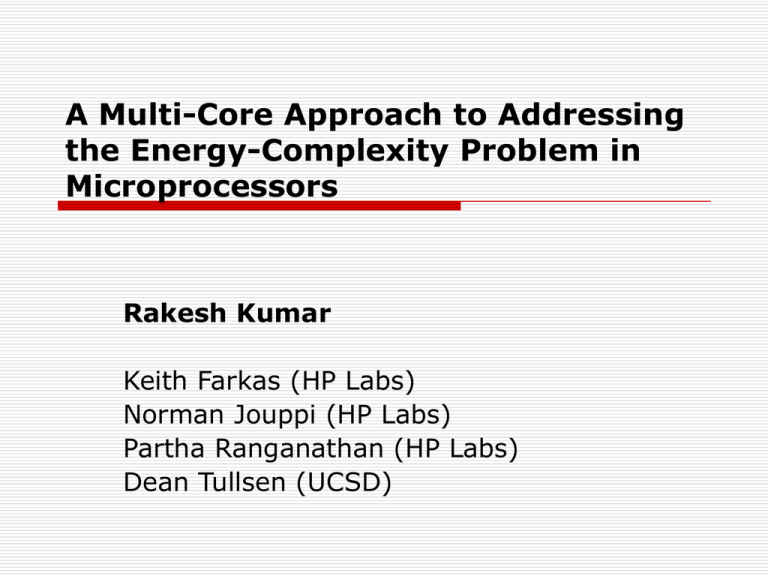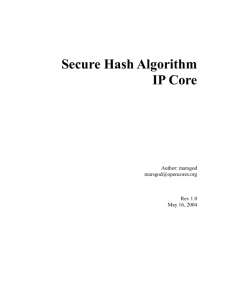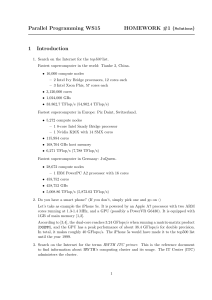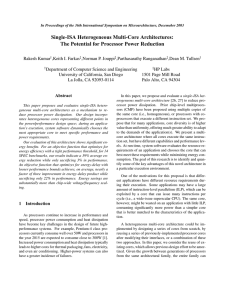PowerPoint
advertisement

A Multi-Core Approach to Addressing the Energy-Complexity Problem in Microprocessors Rakesh Kumar Keith Farkas (HP Labs) Norman Jouppi (HP Labs) Partha Ranganathan (HP Labs) Dean Tullsen (UCSD) Motivation Power is an important issue for processors Going up every successive generation (with complexity) -Up to 150W for Alpha 21464! Past Techniques for Power Reduction Voltage/frequency scaling Limitation: Limited by technology. Also, not possible below a certain feature-size. Architectural Adaptation -shut off portions of core when not needed -dynamic speculation control -reconfigurable caches Limitations: -Very few choices to make -Only dynamic power being saved -Has associated overhead Single-ISA Heterogeneous Multi-Core Architectures Our Proposal Have multiple heterogeneous cores on the same die Match workload (or workload phase) to core that achieves best efficiency according to some objective function (Ensure that the new core has acceptable performance) Power down the unused cores Motivation Hypotheses Performance difference between cores varies based on workload or workload phases Different cores have varying relative energy efficiencies for the same workload Implication: possibility of dynamically changing “best” core Goals of the Paper Validate the hypotheses Get an idea of the design space Get an idea of the potential benefits Outline of Talk Motivation Past Work Our Work Assumptions Decisions Methodology Results and Conclusions Summary and Future Work Choice of Cores on the Die Five Cores on the die: In-order: QED R4700, EV4(Alpha 21064), EV5(Alpha 21164) Out-of-order: EV6 (Alpha 21264),"EV8-“ All cores assumed to be without L2-cache. “EV8-”: Issue width is same as EV8(Alpha 21464) -Resources reduced to account for a single thread. -Core-power dissipation: 100W Properties of the Cores Processor R4700 EV4 EV5 EV6 EV8- Issue-width 1 2 4 6(OOO) 8(OOO) I-Cache 2-way 16KB DM, 8KB DM, 8KB 2-way 64KB 4-way 64KB D-Cache 2-way 16KB DM, 8KB DM, 8KB 2-way 64KB 4-way 64KB Branch Pred. MSHR No 2KB/1-bit 2K-gshare 1 2 4 Notice the gradation! Hybrid 2-levelHybrid 2-level 8 16 Properties of Cores (contd.) Assume all cores implemented in 0.1um -Scaled area and power accordingly Clock Speed? -All Alpha cores assumed to run at 2.1GHz (EV6 frequency at 0.10 micron) -R4700 assumed to run at 1GHz Core Power and Area peak power of core estimated from data sheets - minus that used by L2 caches and pins - then scaled for .1um process area of core estimated from die photos - minus that of i/o pad, wires, L2 cache & control - then scaled for .1um process L2 cache area and power - estimated using CACTI Core Power and Area (contd.) Processor Core-power (in W) Core-area (in mm^2) R4700 0.45 3 EV4 4.97 3 EV5 9.83 5 EV6 17.80 24 EV8- 92.88 260 EV8- consumes 200 times more power than R4700! It is more than 85 times bigger too! Core Power and Area (contd.) Methodology Simulator used: SMTSIM ROB-size, Activelist-size and Load-store queue always kept big enough to ensure no conflicts. Benchmarks used: 14 chosen randomly out of SPEC2000 suite Fast-forwarded for 2 billion instructions, simulated for 1 billion instructions. Data collected after every 1 million instructions. Validating Hypotheses Performance difference between cores varies based on workload or workload phases (IPS) Different cores have varying relative energy efficiencies for the same workload (IPS/W) Performance Variation with Time 2 1.6 1.2 IPS EV8EV6 EV5 EV4 R4700 0.8 0.4 0 1 201 401 601 801 Committed instructions (in millions) Ah! Those clear, distinct phases! Variation of Energy Efficiency with Time 80 70 60 IPS/W 50 R4700 EV4 EV5 EV6 EV8- 40 30 20 10 0 1 201 401 601 801 Committed instructions (in millions) Power dominates IPS/W numbers! How does a composite objective function fare? Energy-delay Product Profile 0.2 R4700 EV4 EV5 EV6 EV8- 0.16 IPS^2/W 0.12 0.08 0.04 0 1 201 401 601 Committed instructions(in millions) 801 So why not run on the “best” core at all points of time?? Choosing Dynamically the Core with Best Energy-Delay Product (perf. loss<50%) 0.2 0.16 R4700 EV4 EV5 EV6 EV8Best-path IPS^2/W 0.12 0.08 0.04 0 1 201 401 601 801 Committed instructions (in millions) Notice the regions where best-path is not along the best energy-delay product! Choosing Dynamically the Core with Best Energy-Delay product (perf. loss<50%) [Summary of Results] Energy-Delay Performance Savings(%) Degradation(%) Maximum Minimum Mean 97.9 0.1 65.4 Number of Switchings: Maximum=387(art) Minimum=0 Median=1 8.5 0.1 18.2 Dissecting the Results More improvements possible – locally-best decisions not necessarily globally-best there was a performance constraint choice of cores not the best for this objective-function cache-configurations not necessarily the best Even for present improvements, beats voltage scaling handsomely(44.2% ED2 improvement) Conclusion Enormous potential for power-savings No leakage-power solution Does considerable IP reuse Complexity-appropriate -every application match to the “appropriate” complexity core Tip of the iceberg? Current/Future Work Cores can be non-ordered Some cores can be multithreaded Throughput impact of the architecture Questions?







